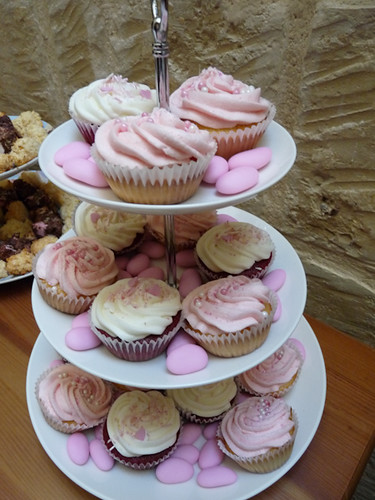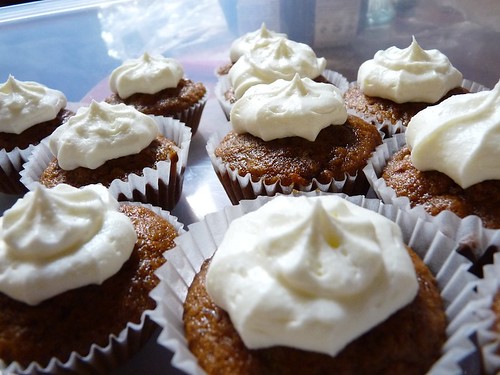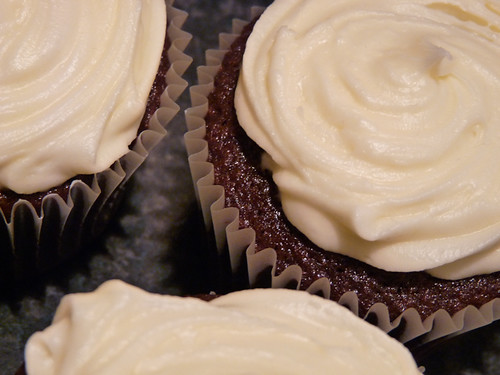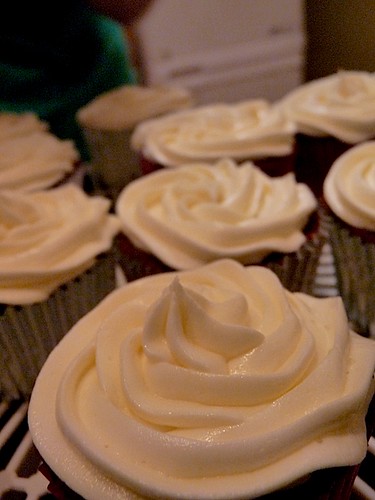 |
| yumyum cakes! |
Frosting is a little funny sometimes, it might work out perfectly one time, and another time it just ends up being a runny mess. here are some pointers to help you get it right.
At the bottom of the post, there are a bunch of pictures, including "successful" and "failure" frostings.
First of all, the most important things - it seems like a stupidly long list, but really, once you've made it once successfully, you'll see it's actually not hard!
Sugar
Icing sugar (known as powdered sugar in the U.S.) must be sifted!
Butter
First of all, and this really needs to go without saying - but it must be REAL butter. No margarine could ever hope to be as tasty as butter. I have made buttercream with marg and it left a horrible greasy film on the roof of my mouth.
I always cook with unsalted butter. And I usually use Continental European butter. I find that Irish/British butter tends to be a little too yellow, greasy, and the flavour is too strong.
The butter must be softened - not melted, not firm, but quite soft (to give you an idea, it should be a little softer than margarine straight out of the fridge). I usually take butter out of the fridge the day before to achieve this (in winter, it doesn't even go into the fridge!). In Maltese summer, I take it out 30 minutes before, otherwise I'll have a butter pool not a stick! Butter lasts quite a long time (weeks) out of the fridge when the temperature is below 18. Seriously, it won't go bad, it won't go rancid. It'll be fine!!
If it's still quite firm when it comes to making the frosting, throw it into the mixer (in cubes) before the butter, and beat it on med-high for about 30 seconds to one minute, then scrape it off the sides with a rubber spatula and beat one more time for a few seconds. It should be soft by then! :) I do this every time in winter in Malta, as my kitchen is quite cold.
The cake
It must be completely cold before frosting. Otherwise your frosting will melt into it.
And not fridge cold (see tips below about refrigerating cakes) either, as there will be condensation and will make the tops of the cake soggy.
Mixer
Ideally, you'll have a free standing electric mixer (like a Kitchenaid or Kenwood) or a hand held electric mixer. Fluffy frosting is possible by hand, but so, so much more laborious and time consuming. Where possible, use a cold metal/ceramic/glass bowl (I have a plastic bowl as the original glass Kenwood bowl broke!)
Cream cheese frosting
Low fat doesn't work at well, unless what you're looking for is a softer, more melty icing. Just face it, you're making a cake, and topping it with frosting. If anything, use less frosting on each cupcake, but don't think for a second that the 20% less fat in one ingredient is going to make an iota of difference to your diet. Do not fool yourself.
Philadelphia works best in summer, as it's the firmest out there. During the other seasons, I just use what's on special. Sometimes when you open the pack, there is a bit of liquid. I always drain this.
Just bear in mind that cream cheese frosting won't ever be quite as fluffy or easy to shape/work with as butter cream frosting, especially in the warmer months. It will always be a little creamier, a little softer. But the taste? Oh the joy! That lovely tang goes so well with so many cakes. I personally much prefer it!
Butter cream frosting
It is pretty much the same method as making cream cheese frosting, except you add a small amount of milk rather than cream cheese. If you are adding more than a drop or 2 of food colouring, reduce the amount of milk accordingly.
Colouring your frosting
Where available, use powdered or gel dyes, as they do not affect the texture of the frosting. If you are using liquid, you should only be making pastel colours and using a few drops. If it's cream cheese frosting, reduce the cream cheese by around a tablespoon (you can always add it in later if you think it needs it!)
Tips for making frosting in summer
Sift an extra 50-100 grams of icing sugar and set it aside, just in case it's a little too liquid/soft and you need to add more.
Where you can, choose butter cream over cream cheese, as you can make this firmer and can beat the living daylights out of it for as long as you like. Personally though, I'd always rather have a more runny frosting, with that delicious tang!
Even though the butter needs to be soft, everything else needs to be as cold as possible. This includes the bowl (I have been known to put even the sugar in the fridge for an hour or so before!)
Put your icing (ready in the piping bag if using) into the fridge for 30 minutes before frosting the completely cool cakes. If you're not piping, cover the frosting directly with cling wrap. What i mean is, not on the top of the bowl, but with the cling wrap touching the surface of the frosting directly, to prevent the sugar from drying out and forming that little crackly sugar crust (you want it to form on the cake, not in the icing bowl!)
Decorating your cakes
Once you have frosted the cakes, give them around 10 minutes before adding the sprinkles/small decorations. The frosting would have hardened enough to stop the colours of the sprinkles from running into the frosting, but not too hard that the sprinkles just bounce off.
Refrigerating your cakes
Ideally, your cakes should never go into the fridge. They get hard, they get soggy, they just go wrong. However, if you've frosted them with cream cheese, and/or if it's summer, you can put them in the fridge in an airtight container, just make sure that you take them out 30 minutes to 1 hour before serving. People made cakes way before fridges exist, just get over your paranoias and trust me on this one! :)
If you feel you must place the cakes in the fridge before they've been frosted, make sure they have returned to room temperature before piping the frosting onto them.
Just as a note: Anyone who has ever eaten my cakes should know that even if I make the cakes a couple of days before, they do not get refrigerated. I store them either in a large baking dish covered with cling wrap (and hidden from view in my cold oven) or in an airtight container. Always in a single layer, as I've learnt from experience that moist cakes tend to leave their tops on the bottoms of the cupcake liners/baking paper above ;)
Frosting the cakes
Before frosting a single cake, place it onto the serving dish/plate
With cupcakes, you don't need to do this, and you can place them onto the serving tray/carry box once they are ready frosted.
METHOD
I found this video by Jamie from Mybakingaddiction (one of my favourite food blogs), which has helped me immensely to pipe frosting. Anyone who knows me knows that my focus is the taste of the cakes, rather than the decoration. Piping is great as with a few fancy sprinkles, you can make cake look so pretty and inviting! This video is simply invaluable and a great start!
To make cream cheese frosting frosting:
300g icing sugar, sifted
50g unsalted butter, at room temperature
125g cream cheese, cold
300g icing sugar, sifted
50g unsalted butter, at room temperature
125g cream cheese, cold
(if you would like lemon flavoured frosting, reduce the cream cheese to 100 grams, and add the zest of a lemon and 1 tablespoon lemon juice!)
Chop the butter into small cubes, and if it's not soft, beat it in the mixer using method above. If it's REALLY cold, put in the
microwave in 5 second intervals until it's soft and pliable.
Sift the icing sugar into a bowl, and add to the mixing bowl.
Work the butter into the icing sugar with the back of a spoon/firm rubber spatula. This is my method of preventing the whole kitchen becoming a cloud of icing sugar, as whilst it does smell quite nice, it's also horrible and messy.
Once you've worked the butter in, using the electric whisk (or free-standing mixer with paddle attachment) mix the butter and icing sugar together until there are no large lumps of butter and it is fully combined with the sugar in an almost super find sand/breadcrumb mixture. You can choose to cover your free-standing mixer with a clean tea-towel at this point, to make sure the clouds of icing sugar don't puff out. but if you've worked in the butter, this shouldn't happen (in winter, it does happen heheh). Having the butter soft/at room temperature REALLY helps for this!
Add the cream cheese and mix at a low speed (I "pulse" it in until it's combined then increase the speed to medium and beat until the frosting is light and fluffy. Be careful not to over-beat the cream cheese frosting, as it can go from voluminous and fluffy to runny in a surprisingly short amount of time. You can beat the hell out of it for a couple of minutes though! It DOES need to be nice and fluffy! Just remember it will go firm before it gets runny.
Work the butter into the icing sugar with the back of a spoon/firm rubber spatula. This is my method of preventing the whole kitchen becoming a cloud of icing sugar, as whilst it does smell quite nice, it's also horrible and messy.
Once you've worked the butter in, using the electric whisk (or free-standing mixer with paddle attachment) mix the butter and icing sugar together until there are no large lumps of butter and it is fully combined with the sugar in an almost super find sand/breadcrumb mixture. You can choose to cover your free-standing mixer with a clean tea-towel at this point, to make sure the clouds of icing sugar don't puff out. but if you've worked in the butter, this shouldn't happen (in winter, it does happen heheh). Having the butter soft/at room temperature REALLY helps for this!
Add the cream cheese and mix at a low speed (I "pulse" it in until it's combined then increase the speed to medium and beat until the frosting is light and fluffy. Be careful not to over-beat the cream cheese frosting, as it can go from voluminous and fluffy to runny in a surprisingly short amount of time. You can beat the hell out of it for a couple of minutes though! It DOES need to be nice and fluffy! Just remember it will go firm before it gets runny.
If it's a warm day, place the frosting into the piping bag (or cover with cling film if not using a piping bag) and place it in the fridge for at least 10 minutes, or up to 30 minutes if it's really hot before using.
Butter-cream
I make vanilla flavoured butter cream, but if you want to make any other flavour, just replace the vanilla extract with whatever flavour you choose!
250 grams icing sugar, sifted
80 grams butter, at room temperature
25 mls full fat milk
a couple of drops of vanilla extract plus a few drops of colouring, if using.
(You're going to notice this is pretty much exactly the same method as making cream cheese frosting!)
Chop
the butter into small cubes, and if it's not soft, beat it in the mixer
using method above. If it's REALLY cold, put in the
microwave in 5 second intervals until it's soft and pliable.
Work the butter into the icing sugar with the back of a spoon/firm rubber spatula. This is my method of preventing the whole kitchen becoming a cloud of icing sugar, as whilst it does smell quite nice, it's also horrible and messy.
Once you've worked the butter in, using the electric whisk (or free-standing mixer with paddle attachment) mix the butter and icing sugar together on very low speed until there are no large lumps of butter and it is fully combined with the sugar in an almost super find sand/breadcrumb mixture (if its warm, it might even all gather together in one lump. This is absolutely fine!! You can choose to cover your free-standing mixer with a clean tea-towel at this point, to make sure the clouds of icing sugar don't puff out. but if you've worked in the butter, this shouldn't really happen. Having the butter at room temperature REALLY helps for this!
Combine the milk, vanilla and a couple of drops of colouring (you can always add the colouring later, especially if you want to split the batch of frosting into smaller amounts with different colours)
Add the milk/vanilla and mix at a
low speed (I "pulse" it in until it's combined then increase the speed
to medium/high and beat until the frosting is light and fluffy. The longer you beat, the lighter and fluffier it will become!
If it's quite soft, you can place it in the fridge for a few minutes before piping, but really, butter cream is best when piped immediately. The surface will harden into a very delicate sugary crust within about 30 minutes, and this actually keeps the cake underneath fresher for longer. Double win! :)
Flavourings
Lemon (or any citrus really!) - Just add the zest of one lemon, lime or whatever fruit you choose, and a tablespoon of juice (more if you like it super lemony) Reduce the milk/cream cheese by whatever amount of juice you add.
Chocolate: Make as the butter-cream recipe above, except with these quantities:
300g icing sugar, sifted
100g unsalted butter, at
room temperature
40 cocoa powder, sifted
40ml whole milk
Sift the cocoa and the sugar together before starting. Again, the longer you beat this, the lighter and fluffier it becomes.
Vanilla: Simply add vanilla bean paste, or extract. reduce the amount of liquid according to how much you add. A few drops should be fine though!
Coffee: Add a shot of espresso and reduce the amount of liquid/cream cheese accordingly. You can use a couple of teaspoons of instant (dissolve it in some liquid, and reduce the milk/cream cheese accordingly)
Use your imagination! The secret is, add less at first, and then add more if you want the flavour to be stronger. It's so much easier than trying to fix it after you've added too much! A few drops goes a long way in frosting!!
----
If you have leftover frosting, you can leave it in the piping bag, refrigerate and use it for the next week or so for sure.
You can also place it in an airtight container and freeze it. To use again, just defrost in the fridge overnight, and mix well with a fork before placing into a piping bag.
N.B. I should add that the basic quantities and method were taken from the Hummingbird Bakery cookbook :)
 |
| Success: Cream cheese frosting coloured with gel dye |
By the time I delivered these babies, the frosting had melted somewhat, in the heat of the sun in the car. The frosting didn't really lose its shape though!
 |
| Semi success, cream cheese frosting. |
These were the first cupcakes I'd ever made, and I didn't pipe on the frosting. In retrospect, i should have beaten the frosting more. Then again, it was mid July and stinking hot, so I'm surprised the frosting actually stayed on the cake and didn't become a pool of delicious sticky soup!
 |
| Lemon Cream cheese frosting |
I simply added zest and juice to the recipe, but made the mistake of not reducing the amount of cream cheese, resulting in a runny mess! It tasted absolutely fantastic though. I actually sometimes prefer it to be this runny when I don't want a lot of frosting on the cakes, so it really is up to you!!
 |
| Success! Cream cheese frosting. |
This was great - it whipped up perfectly, it piped well, it was delicious :) I highly recommend just adding some lemon zest when making frosting for carrot cakes. It compliments it so well!
 |
| Semi success: Buttercream with yellow colouring. |
It was 40 degrees. I think i added about double the amount of sugar to this to keep it from simply being a runny mess. The colour worked out, the taste was fine, the texture was fine but when piping, it kind of looked a bit dry. It wasn't, but the butter/sugar/milk didn't seem to quite emulsify into that beautiful fluffy consistency when piped. It was the best we could do with the situation (outdoor party in that heat!)
 |
| Cream cheese frosting (on the same day as the yellow buttercream above). |
We did pipe some on (see background), and it worked well. Again, we added a lot more sugar to firm it up, and used less cream cheese (and full fat Philly). it was a bit melty, but very tasty!!
 |
| Pink is butter cream, white is cream cheese |
These worked out exactly as per the recipe, exactly as they were supposed to. I coloured the pink frosting with a few drops of red rouge colouring. Very proud of these babies (maybe it was the special love as it was for my niecelet's Christening party!)
 |
| Cream cheese frosting on Chocolate Guinness cakes |
I piped this on, then swirled it a little to get this effect. This worked out well. Great texture!
 |
| Cream cheese frosting on red velvet cakes |
It's hard to know when it's just going to work out well. This was one of those days! It just worked!
The more I think about it, the more I realise that it really does depend on the weather. You cannot follow one simple hard and fast method unless you live in a climate controlled super-dome (and even then it'll probably be too hot!)
I hope this helps you!

Perfect cream cheese buttercream! You're absolutely right about mixing the sugar with the butter first. It took alot of elbow grease, but the buttercream came out just perfect, not runny at all! Thank you so much!!!
ReplyDelete